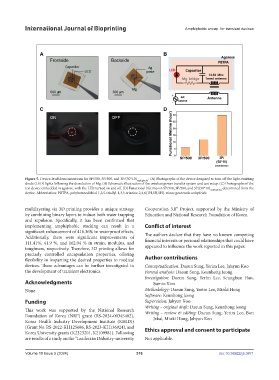Page 324 - IJB-10-5
P. 324
International Journal of Bioprinting Amphiphobic encap. for transient devices
Figure 5. Device-level demonstrations for SP/500, 3P/500, and 3P/(50*10) amphiphobic . (A) Photographs of the device designed to turn off the light-emitting
diode (LED) lights following the dissolution of Mg. (B) Schematic illustration of the wireless power transfer system and test setup. (C) Photographs of the
test device embedded in agarose, with the LED turned on and off. (D) Functional lifetimes in SP/500, 3P/500, and 3P/(50*10) amphiphobic determined from the
device. Abbreviation: PBTPA, polybutanedithiol 1,3,5-triallyl-1,3,5-triazine-2,4,6(1H,3H,5H)-trione pentenoic anhydride.
multilayering via 3D printing provides a unique strategy Cooperation 3.0” Project, supported by the Ministry of
by combining binary layers to induce both water trapping Education and National Research Foundation of Korea.
and repulsion. Specifically, it has been confirmed that
implementing amphiphobic stacking can result in a Conflict of interest
significant enhancement of 416.36% in waterproof effects.
Additionally, there were significant improvements of The authors declare that they have no known competing
111.41%, 41.9 %, and 162.04 % in strain, modulus, and financial interests or personal relationships that could have
toughness, respectively. Therefore, 3D printing allows for appeared to influence the work reported in this paper.
precisely controlled encapsulation properties, offering
flexibility in imparting the desired properties to medical Author contributions
devices. These advantages can be further investigated in Conceptualization: Daeun Sung, Yerim Lee, Jahyun Koo
the development of transient electronics. Formal analysis: Daeun Sung, Keunhong Jeong
Investigation: Daeun Sung, Yerim Lee, Seunghun Han,
Acknowledgments Sumin Kim
None. Methodology: Daeun Sung, Yerim Lee, Minki Hong
Software: Keunhong Jeong
Funding Supervision: Jahyun Koo
Writing – original draft: Daeun Sung, Keunhong Jeong
This work was supported by the National Research Writing – review & editing: Daeun Sung, Yerim Lee, Bon
Foundation of Korea (NRF) grant (RS-2024-00345402), Jekal, Minki Hong, Jahyun Koo
Korea Health Industry Development Institute (KHIDI)
(Grant No. RS-2022-KH125686, RS-2023-KH136924), and Ethics approval and consent to participate
Korea University grants (K2323201, K2109981). Following
are results of a study on the “Leaders in INdustry-university Not applicable.
Volume 10 Issue 5 (2024) 316 doi: 10.36922/ijb.3871

